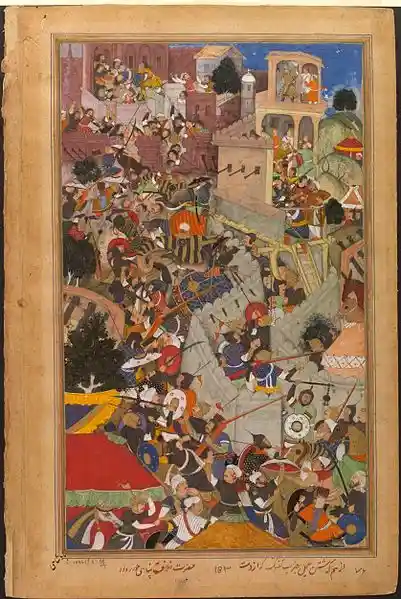The Fall of the Titan
After multiple attacks, many charges and months of laying a siege at Chittor Fort, the Mughal imperial army finally did the almost impossible- they were able to conquer it.

The siege of Chittor as portrayed in a Mughal miniature painting; Source: Public Domain
Two armies raised their lances
They formed ambuscades, and drew up in line
They were all iron-fisted, biters of steel,
All were famous and were clad in iron
The heroes brandished swords red with blood
-Abul Fazl's description of the siege, Akbarnama
We imagine forts to be grand and houses of royal families from a long-forgotten past. But the Chittorgarh fort is a bit different. It’s not just a huge residence of the king and kin, it’s an entire city. To put things into perspective, the fortress is spread over such a vast area that feels less imposing from a distance.
Covering an area of 700 acres, this magnificent structure made up of stone is truly a sight to behold. Passing down from various Rajput lineages- Pratiharas, Parmaras, and Solankis, it eventually became the stronghold of the Sisodiyas of Mewar. Invincible and unconquerable as it seems, history was upturned when Alauddin Khilji sacked the fortress of Chittor in 1303. The impossible had happened and not for the last time.
The Mughal hegemony over India was not achieved easily. While a lot of Rajput states accepted the subordination of Akbar, Mewar did not. The rivalry between these two kingdoms started with the defeat of Rana Sanga at the hands of Babur at the Battle of Khanwa. Udai Singh, the king of Mewar, and his son Pratap refused to act as vassals of Akbar. When all diplomatic missions failed, Akbar decided to lay siege to Chittor, one of the most formidable fortresses of India.
The strategy of Mewar was to resist facing the Mughals on the battlefield and instead lure them to Chittor which was left with a 5,000 man garrison under the command of Rao Jaimal and Patta. It took Akbar a month to lay his siege lines.
While the Mughal imperial forces kept raiding the area around the fort, they could not breach its walls. 58 days into the siege, they were finally able to attack it after blasting off gunpowder mines.
The night of 22nd February marks a decisive moment when Akbar’s soldiers sacked the fort of Chittorgarh. In a fierce battle, Rao Jaimal was killed after a musket shot hit him. He kept fighting despite his injury but could not sustain the charge for long. It is said that Jaimala and Patta fought with such valour that Akbar ordered their statues to be constructed. Tales in respect of these great fallen warriors are sung in Rajasthan till day. Amidst the blood bath and massacre, the women of the Sisodiya performed Jauhar or self-immolation.
“No place on earth,” says Count Keyserling about Chitor, “has been the scene of equal heroism, knightliness, or an equally noble readiness to die.”
Chittor lay wasted by the brutal charge of the Mughal imperial army. On 23rd February 1568, Akbar stepped into the Chittor fort as the victor king. This victory was a clear declaration of the might of Mughals, but it was not unchallenged. Rana Pratap would continue fighting Akbars for many years despite losing Chittor and the fort could never be restored to its original glory.


